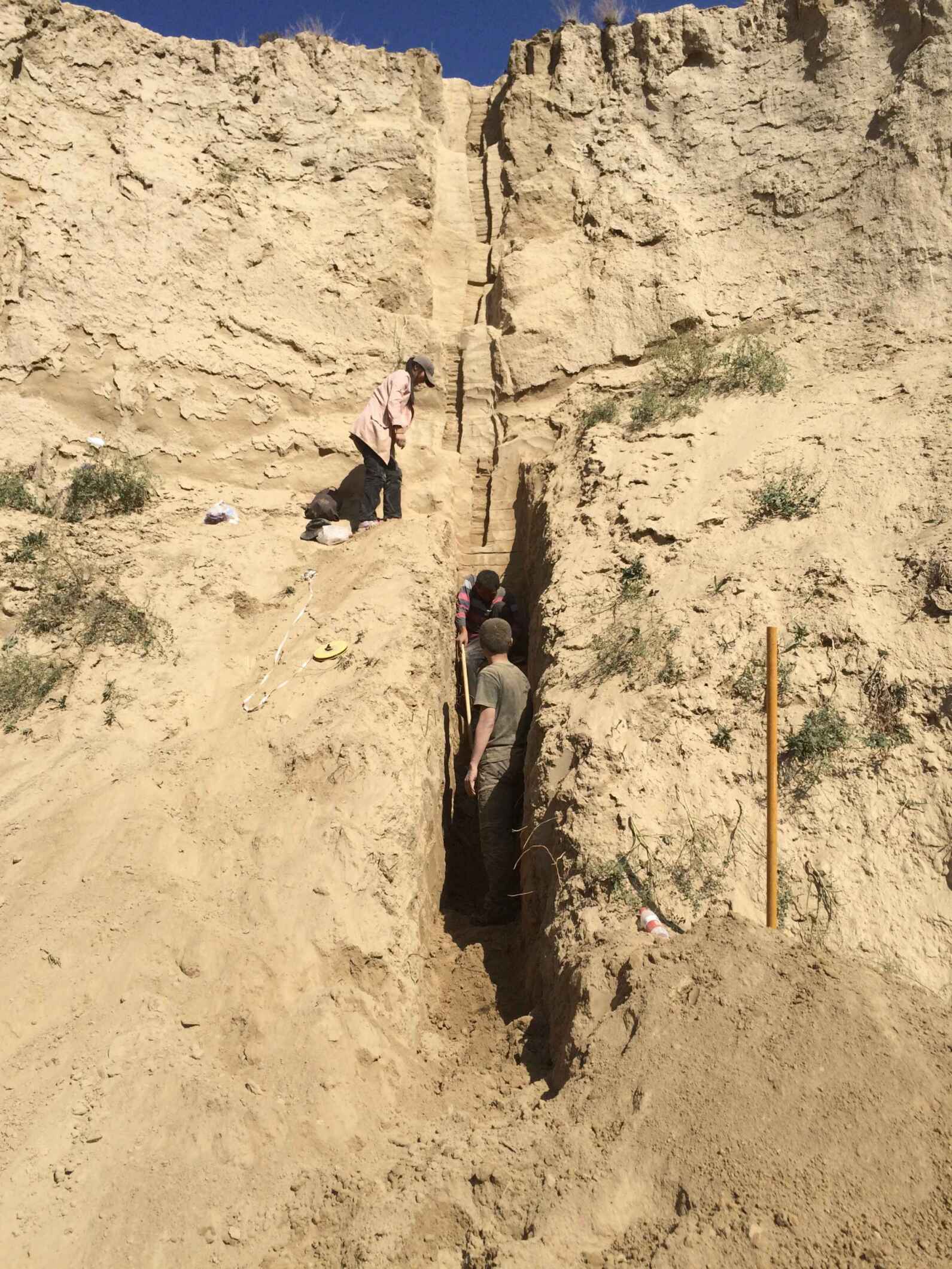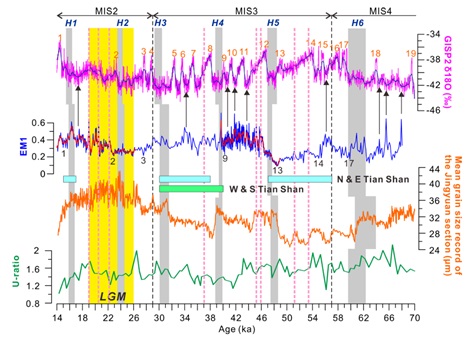
Field work on Loess profile(Image by Song et al. )
The westerlies-dominated area of arid Central Asia is the furthest dust source from the oceans and plays an important role in global change. Central Asia is also one of the most significant loess landscapes on earth, located between the well-studied European loess sequences to the west and the extensive Chinese Loess Plateau to the east. This enables researchers to carry out interregional paleoclimatic investigations along a west-east transect across the entire Eurasian loess belt of the Northern Hemisphere. However, Central Asian loess is still far from intensively investigated, there are few reports of climatic change during the last glacial period in Central Asia, dust formation and climatic forcing mechanisms are yet not systematically understood.
Recently, a new paper about Central Asian loess has been published in Climate of the Past (Li et al, 2018). This study investigated magnetism and sedimentology proxies of loess sections in the Ili Basin, eastern Central Asia, and elucidated environmental dynamics for dust accumulation and paleoclimate change. This study found that magnetic susceptibility (MS) was more strongly influenced by allogenetic magnetic minerals than pedogenesis and might therefore be used to indicate wind strength. To further explore the temporal variability in dust transport patterns, the authors separated loess grain size distributions based on the hierarchical Bayesian model for end-member modeling analysis. Three grain size end-members (EM1, mode size 47.5 μm; EM2, 33.6 μm; EM3, 18.9 μm) were generated. These EMs represent distinct aerodynamic environments. EM1 and EM2 are inferred to represent grain size fractions transported from proximal sources in short-term, near-surface suspension during dust outbreaks. EM3 appears to represent a continuous background dust fraction under non-dust storm conditions. The authors selected EM1 as the most sensitive proxy of wind strength. Comparisons of the EM1 proportions with mean grain size from the Jingyuan loess section in the Chinese Loess Plateau (Fig.1), considering modern and Holocene climate data, the authors argued that the Siberian High (SH) pressure system was the dominant influence on wind dynamics. This study is of significance for understanding the climatic implications of loess proxies, source tracing of Central Asian dust. Furthermore, six millennial-scale cooling (Heinrich) events were identified from the loess grain size records. These data supported the transmitting mechanisms hypothesis that the SH acted as teleconnection between the climatic systems of the North Atlantic and East Asia. It provides new evidences for the climatic teleconnection between high latitudes in the northern Hemisphere and Chinese Loess Plateau.

Fig. 1 Comparison between EM1 grain size variability and the timing of glacial advances in the Tian Shan (Koppes et al., 2008; Owen and Dortch, 2014); stable oxygen isotope variations from the Greenland ice cores (Rasmussen et al., 2014); mean grain size (MGS) record of the Jingyuan loess section from the CLP (Sun et al., 2010) and; U-ratio (15.6–63.4 µm/ 5.61–15.6 µm) of the SE Kazakhstan loess (Machalett et al., 2008). A five-point running average was performed for the intervals with higher sedimentary rate on EM1 curve (red line). (Image by Song et al. )
Recent related publications of Central Asian loess group in IEECAS:
Chen, X.L., Song, Y.G., Li, J.C., Fang, H., Li, Z.Z., Liu, X.M., Li, Y., Orozbaev, R., 2017. Size-differentiated REE characteristics and environmental significance of aeolian sediments in the Ili Basin of Xinjiang, NW China. Journal of Asian Earth Sciences 143, 30-38. http://dx.doi.org/10.1016/j.jseaes.2017.03.030
Kang, S., Wang, X., Lu, Y., Liu, W., Song, Y., Wang, N., 2015. A high-resolution quartz OSL chronology of the Talede loess over the past ~ 30 ka and its implications for dust accumulation in the Ili Basin, Central Asia. Quaternary Geochronology 30, 181-187. http://dx.doi.org/10.1016/j.quageo.2015.04.006
Li, Y., Song, Y., Zeng, M., Lin, W., Orozbaev, R., Cheng, L., Chen, X., Halmurat, T., 2017. Evaluating the paleoclimatic significance of clay mineral records from a late Pleistocene loess-paleosol section of the Ili Basin, Central Asia. Quaternary Research.1-14. https://doi.org/10.1017/qua.2017.58
Li, Y., Song, Y.G., Chen, X.L., Li, J.C., Mamadjanov, Y., Aminov, J., 2016a. Geochemical composition of Tajikistan loess and its provenance implications. Palaeogeography Palaeoclimatology Palaeoecology 446, 186-194. http://dx.doi.org/10.1016/j.palaeo.2016.01.025
Li, Y., Song, Y.G., Fitzsimmons, K.E., Chang, H., Orozbaev, R., Li, X.X., 2018. Eolian dust dispersal patterns since the last glacial period in eastern Central Asia: insights from a loess-paleosol sequence in the Ili Basin. Climate of the Past 14, 271-286. https://doi.org/10.5194/cp-14-271-2018
Li, Y., Song, Y.G., Lai, Z.P., Han, L., An, Z.S., 2016b. Rapid and cyclic dust accumulation during MIS 2 in Central Asia inferred from loess OSL dating and grain-size analysis. Scientific Reports 6, e32365:1-6. https://www.nature.com/articles/srep32365/figures/
Li, Y., Song, Y.G., Yan, L.B., Chen, T., An, Z.S., 2015. Timing and Spatial Distribution of Loess in Xinjiang, NW China. Plos One 10. e0125492. https://doi.org/10.1371/journal.pone.0125492
Song, Y.G., Luo, D., Du, J.H., Kang, S.G., Cheng, P., Fu, C.F., Guo, X.H., 2018a. Radiometric dating of late Quaternary loess in the northern piedmont of South Tianshan Mountains: Implications for reliable dating. Geological Journal online, 1-10. https://doi.org/10.1002/gj.3129.
Song, Y.G., Li, Y., Wang, Q., Dong, H., Zhang, Z., Orozbaev, R., 2018b. Effect of chemical pretreatments on magnetic susceptibility of loess from Central Asia and the Chinese Loess Plateau. Rsc Advances 8, 11087-11094. https://doi.org/10.1039/C8RA00617B
Song Y. G., Zeng M. X., Chen X. L., Li Y., Chang H., An Z. S., Guo X. H., 2018c. Abrupt climatic events recorded by the Ili loess during the last glaciation in Central Asia: Evidence from grain-size and minerals. J Asian Earth Sci, 155: 58-67. http://dx.doi.org/10.1016/j.jseaes.2017.10.040
Song, Y.G., Chen, X.L., Qian, L.B., Li, C.X., Li, Y., Li, X.X., Chang, H., An, Z.S., 2014. Distribution and composition of loess sediments in the Ili Basin, Central Asia. Quaternary International 334, 61-73. http://dx.doi.org/10.1016/j.quaint.2013.12.053
Song, Y.G., Lai, Z.P., Li, Y., Chen, T., Wang, Y.X., 2015. Comparison between luminescence and radiocarbon dating of late Quaternary loess from the Ili Basin in Central Asia. Quaternary Geochronology 30, 405-410. http://dx.doi.org/10.1016/j.quageo.2015.01.012
Song, Y.G., Li, C.X., Zhao, J.D., Chen, P., Zeng, M., 2012. A combined luminescence and radiocarbon dating study of the Ili loess, Central Asia. Quaternary Geochronology 10, 2-7. https://doi.org/10.1016/j.quageo.2012.04.005
Song, Y.G., Li, Y., Li, Y., An, Z., Cheng, L., Sun, H., Rustam, O., 2017. North Atlantic Abrupt Climate Signals during the Last Glacial Period in Central Asia: Evidences from Aeolian Loess Sediments. Acta Geologica Sinica-English Edition 91, 1135-1136. https://doi.org/10.3969/j.issn.1000-9515.2017.05.038
Yang, S.L., Forman, S.L., Song, Y.G., Pierson, J., Mazzocco, J., Li, X.X., Shi, Z.T., Fang, X.M., 2014. Evaluating OSL-SAR protocols for dating quartz grains from the loess in Ili Basin, Central Asia. Quaternary Geochronology 20, 78-88. http://dx.doi.org/10.1016/j.quageo.2013.11.004
Zeng, M.X., Song, Y.G., Li, Y., Fu, C.F., Qiang, X.K., Chang, H., Zhu, L.D., Zhang, Z.P., Cheng, L.Q., 2018. The relationship between environmental factors and magnetic susceptibility in the Ili loess, Tianshan Mountains, Central Asia. Geological Journal online, 1-13. https://doi.org/10.1002/gj.3182.
Contact: SONG Yougui, State Key Laboratory of Loess and Quaternary Geology, Institute of Earth Environment, Chinese Academy of Sciences, Xi'an 710061, China. Email:syg@ieecas.cn
 © 2015 Institute of Earth Environment,CAS
© 2015 Institute of Earth Environment,CAS Address:No. 97 Yanxiang Road, Xi'an 710061, Shaanxi, China

 Location :
Location :